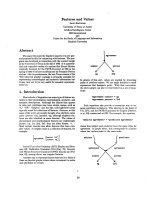Pricing and value
Bạn đang xem bản rút gọn của tài liệu. Xem và tải ngay bản đầy đủ của tài liệu tại đây (2.22 MB, 50 trang )
Presented by Khoa Nguyễn
Story of the day
Topic Outline
1. Price Definition – antidumping
2. Pricing Methods –
equilibrium point
3. Pricing Considerations
4. New Product Price
Strategies
5. Product Mix Price Strategies
1. Price Definition
What is price?
• the sum of all the values that
consumers give up in order to gain
the benefits of having or using a
product or service.
Pricing in
Marketing 4.0
Pricing in Marketing 4.0
1
Get instant price
comparisons
from thousands
of vendors.
2
Check prices at
the point of
purchase
3
4
Name their price
and have it met
Get products free
Synonyms for Price
•
•
•
•
•
•
•
Tuition
Fee
Fare
Rate
Toll
Premium
Rent
•
•
•
•
•
•
•
Special assessment
Bribe
Dues
Salary
Commission
Wage
Tax
Common
Pricing
Mistakes
• Determine costs and take traditional industry
margins
• Failure to revise price to capitalize on market
changes
• Setting price independently of the rest of the
marketing mix
• Failure to vary price by product item, market
segment, distribution channels, and
purchase occasion
2. Pricing Methods
Setting Prices
VA L U E - B A S E D
COST-BASED
Assess needs and
value perceptions
Design a product
Set target price
Determine costs
Determine costs
Set price based on cost
Design a product
Convince buyers of the
value
Value-based pricing
• uses buyers’ perceptions of value, not
sellers’ cost, as the key to pricing.
Cost-based pricing
3. Steps in Setting
Price
Steps in Setting Price
Survival
Step 1:
Selecting
the Pricing
Objective
Maximum current profit
Maximum market share
Maximum market skimming
Product-quality leadership
Price Sensitivity
Step 2:
Determining
Demand
Estimating Demand
Curves
Price Elasticity of
Demand
• The product is more distinctive
• Buyers are less aware of substitutes
Factors
Leading to
Less Price
Sensitivity
• Buyers cannot easily compare the quality of substitutes
• The expenditure is a smaller part of buyer’s total income
• The expenditure is small compared to the total cost of
the end product
• Part of the cost is paid by another party
• The product is used with previously purchased assets
• The product is assumed to have high quality and prestige
• Buyers cannot store the product
Elasticity of demand
Elasticity
of demand
Elastic
Inelastic
Step 3: Estimating Costs
Types of Costs
Target Costing
Types of
costs
FIXED COSTS
+
VARIABLE COSTS
=
TOTAL COSTS
TARGET
COSTING
• TARGET COSTING: starts with an
ideal selling price based on
customer-value considerations, and
then targets costs that will ensure
that the price is met









